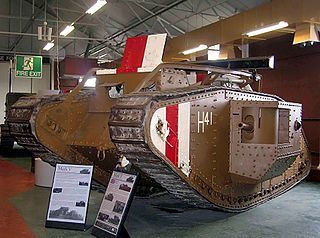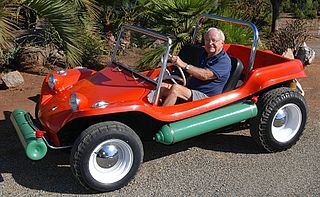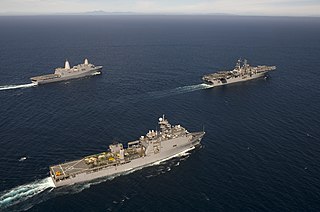
An armoured fighting vehicle or armored fighting vehicle (AFV) is an armed combat vehicle protected by armour, generally combining operational mobility with offensive and defensive capabilities. AFVs can be wheeled or tracked. Examples of AFVs are tanks, armoured cars, assault guns, self-propelled artilleries, infantry fighting vehicles (IFV), and armoured personnel carriers (APC).

Mechanized infantry are infantry units equipped with armored personnel carriers (APCs) or infantry fighting vehicles (IFVs) for transport and combat.

A technical, known as a non-standard tactical vehicle (NSTV) in United States military parlance, is a light improvised fighting vehicle, typically an open-backed civilian pickup truck or four-wheel drive vehicle modified to mount SALWs and heavy weaponry, such as a machine gun, automatic grenade launcher, anti-aircraft autocannon, rotary cannon, anti-tank weapon, anti-tank gun, ATGM, mortar, multiple rocket launcher, recoilless rifle, or other support weapon, etc.

A dune buggy — also known as a beach buggy — is a recreational off-road vehicle with large wheels, and wide tires, designed for use on sand dunes, beaches, off-road or desert recreation. The design is usually a topless vehicle with a rear-mounted engine. A dune buggy can be created by modifying an existing vehicle or custom-building a new vehicle.

The New York class was a pair of super-dreadnought battleships built for the United States Navy between 1911 and 1914. The two ships of the class, New York and Texas, saw extensive service beginning in the occupation of Veracruz, World War I, and World War II.

The M242 Bushmaster chain gun is a 25 mm (25×137mm) single-barrel chain-driven autocannon. It is used extensively by the U.S. military, such as in the Bradley fighting vehicle, as well as by other NATO members and some other nations in ground combat vehicles and various watercraft. Hughes Helicopters in Culver City, California, was the original designer and manufacturer. As of 2019, Northrop Grumman Innovation Systems produces the gun.

The Desert Patrol Vehicle (DPV), formerly called the Fast Attack Vehicle (FAV), is a Chenowth high-speed, lightly armored sandrail-like vehicle first used in combat during the Gulf War in 1991. Due to their dash speed and off-road mobility, the DPVs were used extensively during Operation Desert Storm. The first U.S. forces to enter Kuwait City were United States Navy SEALs in DPVs.

1st Light Armored Reconnaissance Battalion is a fast and mobilized armored terrestrial reconnaissance battalion of the United States Marine Corps. Nicknamed the "Highlanders," their primary weapon system is the LAV-25 Light Armored Vehicle armed with the M242 25mm Bushmaster chain gun. They fall under the command of the 1st Marine Division and the I Marine Expeditionary Force. The unit is based out of the Marine Corps Base Camp Pendleton, California.

The M1117 armored security vehicle is an internal security vehicle based on the V-100 and V-150 Commando series of armored cars. It was developed in the late 1990s for service with the United States' Military Police Corps. The first prototypes appeared in February 1997 and serial production of the M1117 commenced between 1999 and early 2000.

The Dragoon 300 AFV was produced by Arrowpointe Corporation during the 1980s. It was based on the automotive components of the United States Army's M113 APCs and 5-ton trucks. It resembles a larger V-150 Commando.

The Light Strike Vehicle (LSV) is an improved version of the Desert Patrol Vehicle (DPV), which it was designed to replace. Special operation groups adopted the LSV for its small size and high mobility. It is part of the family of Internally Transportable Light Strike Vehicles (ITV-LSV). As the name suggests, it is used for fast hit-and-run style raids, scouting missions, special forces support, and low intensity guerrilla warfare.

The Interim Fast Attack Vehicle (IFAV) is a reconnaissance vehicle deployed and used by the United States Marine Force Recon and Marine Expeditionary Units. Force Recon used to operate a fleet of Desert Patrol Vehicles, popularized by the Navy SEALs as the "black dune buggy." However, this vehicle lacked cargo capacity and firepower, so Force Recon moved to a militarized Mercedes-Benz G-Class, also known as a G-wagen, 290 GDT diesel 4×4, a much more traditional "Jeep" type truck. The vehicle has only minimal armor, but numerous defensive weapons, including a Mk 19 automatic 40 mm grenade launcher. This vehicle is manufactured by Magna Steyr (Austria) for Mercedes-Benz (Germany).

An amphibious warfare ship is an amphibious vehicle warship employed to land and support ground forces, such as marines, on enemy territory during an amphibious assault.

The M1161 Growler is officially the Internally Transportable Light Strike Vehicle (ITV-LSV) designed specifically for use with the V-22 Osprey tiltrotor aircraft. The M1161 and M1163 were the only tactical vehicles certified to fly in the V-22. Fulfilling multiple roles of light utility, light strike and fast attack vehicle, the M1161 Growler is smaller than most international vehicles in the same role. It has taken over duties of the M151 jeep-type variants and replaced the Interim Fast Attack Vehicle (IFAV).
The Light Strike Vehicle (LSV) is a light fast attack vehicle used by the Singapore Army. In 2013, the Singapore-designed and -made Light Strike Vehicle Mark II entered service to replace the ageing Singapore and Australian-made Light Strike Vehicle in service since 1998.

The Ground Mobility Vehicle (GMV) is a U.S. Special Operations Command, (US)SOCOM program, initially modifying Humvees into several variants for use by the United States special operations forces (SOF).

Mahindra Armored Light Specialist Vehicle is a light-weight four-wheel drive air transportable tactical armoured specialist vehicle designed by Mahindra & Mahindra for the Indian Army and the Indian Special Forces. It's a modular type vehicle built to be maintenance friendly, and can be upgraded and configured for wide range of roles.

The AMZBóbr-3 is a Polish wheeled amphibious armoured reconnaissance vehicle. This vehicle is part of a larger effort to replace the aging BRDM-2 armoured reconnaissance vehicles with more advanced platforms under the new Lekkiego Opancerzonego Transportera Rozpoznawczego (LOTR) 'Light Armoured Reconnaissance Transporter' program code-named Kleszcz (Tick).

















